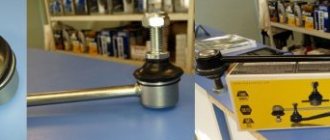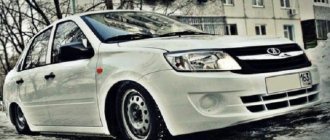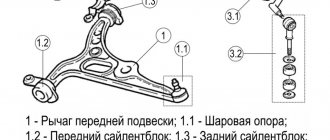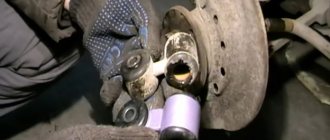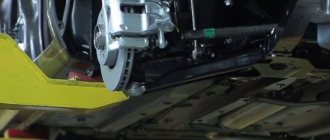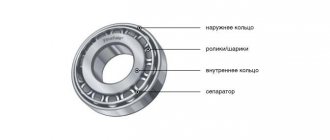The front and rear suspension of Vesta differs significantly from the one that AVTOVAZ used on Grant, Priora, Kalina, etc. All the reviews tell us that the new chassis design is better than before. However, during the first months of operation, the owners began to notice extraneous noises (knocks, creaks, rattles, crunches) in the front and rear suspensions of Vesta, which occur when driving over speed bumps or other road irregularities...
Rattle in the front suspension on Lada Vesta
The most common cause of squeaking is the stabilizer bushing
The increasing grinding noise of the front suspension of the Lada Vesta is especially worrisome, because the main load , the steering and braking systems are located, the condition of which must always correspond to the norm.
A front-wheel drive car, as in our case, is prone to problems with the nose.
Creaks in the suspension are Vesta's disease!
Even new Vestas begin to creak after a short period of operation.
Inspection of the front suspension.
The very first cause of the malaise is considered to be an unfinished design of polyurethane stabilizer bushings , which almost immediately begin to make groaning sounds when driving through plump speed bumps. In wet weather he begins to moan constantly, which is very exhausting.
This problem can be corrected in several ways, radical and not so radical:
- Replacement of pillows with analogues from Chevrolet Niva or other suitable foreign cars.
- Regular application of mastic to places where polyurethane rubs against metal.
- Wait until AvtoVAZ corrects the defect, inviting everyone to the service station for a replacement.
Knocks, crunching in the rear suspension
_x000D_
_x000D_
In the rear suspension, knocking is eliminated according to AvtoVAZ's instructions. It is necessary to remove the rear shock absorber strut and place a washer under the upper support (No. 5).
_x000D_
washer to eliminate knocking and crunching in the rear suspension of Vesta
washer to eliminate knocking and crunching in the rear suspension of Vesta
_x000D_
It is worth noting that after such modification, a gap appears between the support and the body, into which dirt can get in. To eliminate this, it is recommended to install a gasket according to the following dimensions:
_x000D_
Lada Vesta rear shock absorber support gasket
_x000D_
_x000D_
Other sources of extraneous noise from the rear:
_x000D_
- _x000D_
- handbrake cable (fasten to ties);
- trunk lid dampers (lubricate with silicone grease, loosen);
- trunk lock (lubricate the lock, eliminate play);
- in the area of the rear support, pull the bump stop down along the strut rod (pull it out of the support sleeve), spray silicone spray into the support sleeve and put the bump stop in place.
- rear seat back locks (lubricate, apply electrical tape).
- things or tools in the trunk.
_x000D_
_x000D_
_x000D_
_x000D_
_x000D_
_x000D_
_x000D_
How to diagnose the Vesta suspension yourself. If the rear knock only appears when braking, then this is a different case.
_x000D_
If you encounter a similar problem, we recommend contacting your personal manager. Have you noticed the appearance of knocks or creaks in the Vesta suspension? How did you manage to get rid of them? Leave your reviews and recommendations in the comments.
_x000D_
Let us remind you that another drawback of this sedan is associated with the creaking of the glass seals. Other instructions for tuning and modifying the new Lada can be found in this category.
Problem with stabilizer links
The problem with squeaks in the front suspension can be solved by replacing the stabilizer bushings with polyurethane.
If after performing one of the operations the grinding does not stop, then you can go further down the list.
What else could be wrong with stabilizers? The design has a strut that is attached to the shock absorber body and the cross member of the stabilizer itself. It has two fingers as fastening. Without diagnostics at a service station, it will not be easy to figure out whether there is a breakdown in this unit, but you can try.
Official opinion of AvtoVAZ
Dealers replace stabilizer links free of charge. But sometimes you have to butt heads!
The problem with the struts is not far-fetched , since in April 2021, official representatives of AvtoVAZ reported that they knew that after just a few thousand kilometers Vesta was already detecting knocking and creaking noises from this particular unit. This important element experiences special stress and wears out prematurely.
There was no word on whether the fault was a manufacturing defect.
Replacement of struts on Lada Vesta for free
Replacement of squeaking elements at the dealer should be free of charge. All questions can be resolved by calling the hotline!
However, all car owners who complain about the performance of the struts during the warranty period will have them completely replaced at the dealership free of charge .
It is noteworthy that we are not talking about installing a repair kit, but a complete replacement of the unit.
So, if the warranty has expired, you will have to try to solve the problem yourself. The replacement process is simple. After inspecting the removed parts, you can decide whether to replace the entire mechanism or limit yourself to a repair kit.
Front suspension device
The design of the unit has changed noticeably. Even before repairing new Vests, technical centers had to be trained on the new model. The front suspension sits on a subframe, which was not seen on earlier VAZ models. As a result, the upper part above it (engine compartment, steering rack, etc.) received protection, and the lower part of the suspension received static fasteners. The steering rack, which is located above the subframe, is still located slightly lower than it was on previous models. This means that the steering linkage now works directly with the steering knuckle.
The steering shaft is supplemented with an electric power steering, which transmits the turning forces of the steering wheel to the wheels. The rack transmits force to the rods, and they work with the hubs - they allow you to control the movement of the wheels under control. The hub is also pressed against the disc brake, controlling the uniformity of its contact with the wheel.
The suspension itself is independent; on the Lada Vesta, the front mechanism levers are L-shaped. The right and left front suspension arms operate independently of each other. The transverse stabilizer has undergone modifications, which gave the car greater maneuverability, as well as better cornering control. Its struts are more like a sports car, they smooth out the effect of such maneuvers at speed.
Other causes of squeaks in the front suspension
Lada Vesta does not have any other serious problems other than those listed above.
The front suspension is designed reliably, similar to foreign brands, taking into account long-term use.
Quite often, extraneous squeaks are caused by brake calipers.
There are isolated cases where the following types of breakdowns have occurred over time:
- The silent blocks of the steering gear levers require , which are extremely inconvenient to remove.
- Brake calipers may gradually begin to click , replacing the pins may solve this problem.
- A small play appears in the place where the strut cups are attached to the body , associated with wear on the threads of the mounting bolts.
Front suspension problems
Significant defects in the front part of the Lada Vesta, which are accompanied by external noise:
1. Rumble in the stabilizer; 2. Knock on the right side of the ball joint; 3. The stabilizer struts are rattling.
All these problems are fixed at AvtoVAZ centers. When driving over an uneven surface, a dull knock appears as if rubber is rubbing. The muffler mount must be lubricated with grease.
In the front suspension of the Lada Vesta, a creaking noise may indicate wear on the struts. This defect can be eliminated by replacing with new ones.
conclusions
In addition to these factors, time plays a decisive role.
If the service life of some units has come to an end, then they need to be replaced urgently, since one breakdown can lead to others, and the entire mechanism will go into disarray.
If we return a little to squeaks, then with significant fatigue of the ball joints, steering tip and rack, failure of the shock absorber, or its broken supports, unnatural irritating sounds may appear. Then it is best to go for a diagnosis and then treat the problem.
Lada Vesta replacement stabilizer bushings
You may know that many cars contain stabilizer bars (beams) in their design - either on the front axle or on both.
On Vesta, stabilizers (beams) of lateral stability are installed by the factory only at the front.
The stabilizer is designed to combat lateral rolls (for example, during a turn), preventing a possible rollover. With such a beam, the car has greater stability on the road, and you are less likely to lose reliable grip on the road.
The stabilizer kit includes the following elements:
- Barbell
- Mounting bracket (clamp)
- Bushing (cushion)
- Rack
- Mounting bolt
The stabilizer bar for Vesta is made of spring steel, which is installed on the subframe using brackets and bushings. The rod is also attached to the front suspension shock absorbers with appropriate struts.
During the lateral tilt of the machine, the stabilizer links move (one moves up, the other moves down), resulting in an even distribution of the load between the chassis parts.
In this case, the stabilizer bushings play a very important role - they allow the bar to twist around its axis during load, ensuring stabilization of the car’s position on the road.
[pp_youtube src=»https://www.youtube.com/embed/qijOBOs7yYw?feature=oembed» ]
The bushings are replaced if they are worn out. The results of wear can be:
- Extraneous sounds from the front suspension.
- Creaking occurs when driving on uneven roads or after driving through puddles.
- Reduced controllability in the speed range from 60 to 90 km/h.
The causes of wear are the aggressive action of the environment (road dirt, reagents) or poor manufacturing quality of the bushings.
When should you change bushings?
Routine work to replace these elements, according to AvtoVAZ recommendations, should be carried out after 25-30 thousand kilometers.
In practice, they often have to be changed more often . At the slightest suspicion, it is necessary to inspect the bushings for cracking or destruction of the rubber. If the bushings do become unusable, you cannot put off replacing them, because the technical condition of the suspension directly affects both the quality of driving and traffic safety.
Factory bushings are made of rubber. If they wear out, we recommend installing new polyurethane products, since they are not subject to such intense wear, have increased resistance to the negative effects of aggressive environments (water, acids, oils, gasoline, reagents, etc.), and do not deform under high loads , and also do not lose their plastic properties over a wide temperature range.


